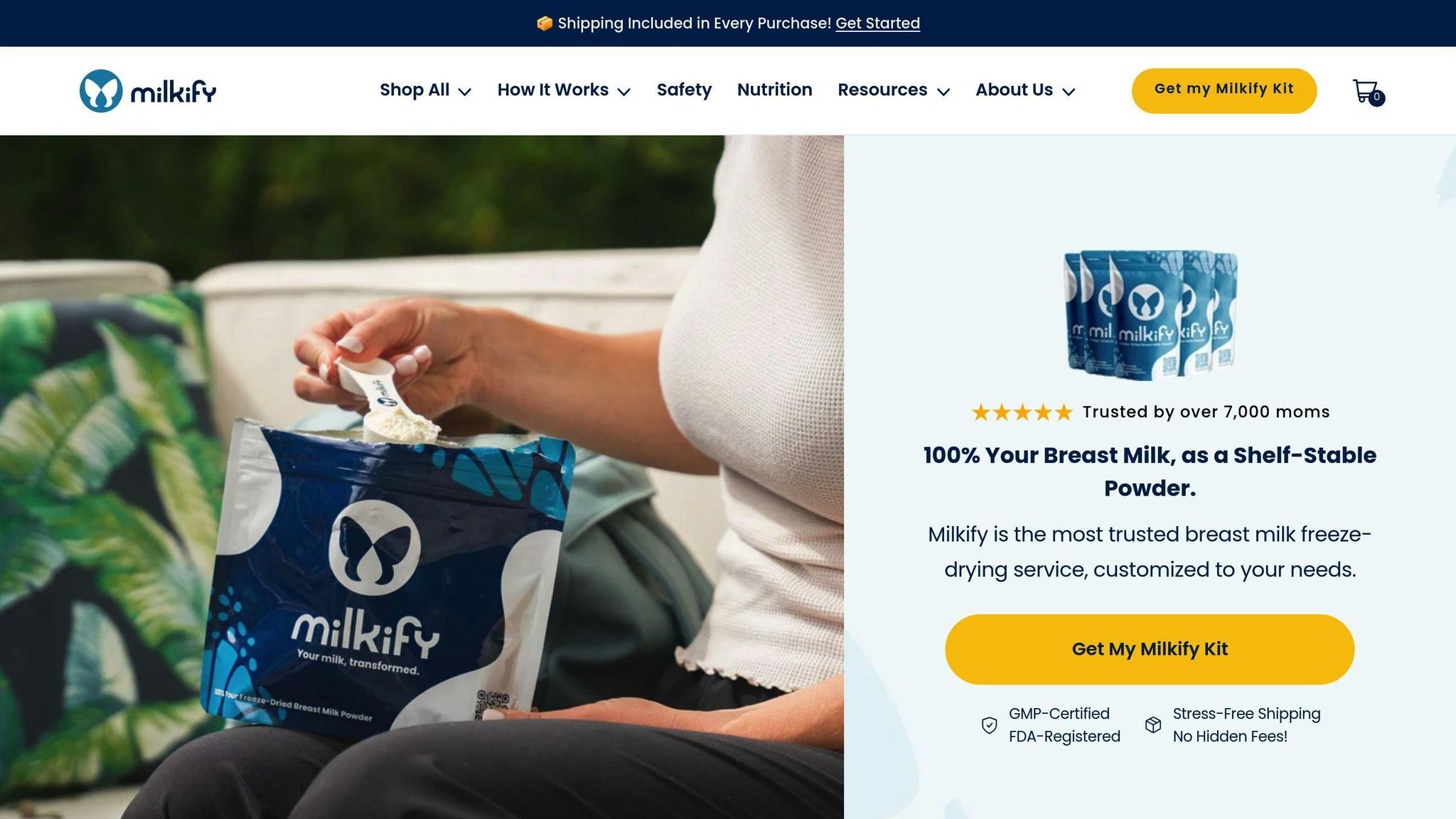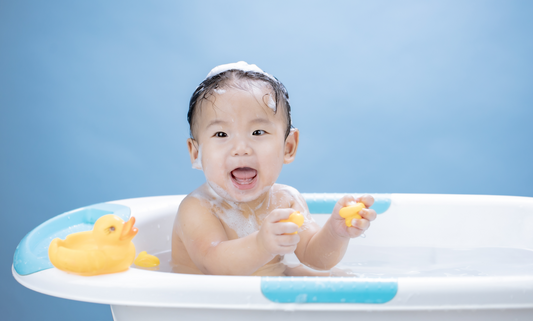Storing breast milk properly ensures it stays safe, nutritious, and ready for your baby. Here’s what you need to know:
- Use the Right Containers: Stick to BPA-free, commercially available lactation bags. Freeze the milk flat and put it in the freezer right away after expressing, even if you pump small quantities at a time.
- Label Everything: Always date your milk and organize it by age to use older batches first and avoid waste.
- Don’t Overfill: Leave space in containers for milk to expand during freezing to prevent leaks or damage.
- Thaw Safely: Use the fridge, warm water, or a bottle warmer. Never microwave or refreeze thawed milk.
- Follow Storage Time Limits: Fresh milk lasts 2 hours at room temperature, 4 days in the fridge, and up to 12 months in the freezer (6 months for best quality).
Quick Tip: Consider advanced methods like freeze-drying with Milkify for long-term storage or travel. It keeps milk shelf-stable and nutrient-rich for up to 3 years.
Storing Breastmilk: Complete Temperature and Storage Guidelines
1. Mistake: Using the Wrong Storage Containers
Picking the wrong storage containers can lead to contamination and compromise the quality of your breast milk. This can result in wasted milk or even pose health risks for your baby.
Choosing the Right Containers
The best way to store breast milk is to use containers specifically made for this purpose. Look for food-grade glass containers or BPA-free hard plastic bottles with secure lids. These options help maintain milk quality and reduce the risk of bacterial growth.
| Container Type | Benefits | Best Use Case |
|---|---|---|
| Breast Milk Storage Bags | Pre-sterilized, space-saving | Regular freezer storage |
| Screw-cap Bottles | Durable, reusable | Refrigerator storage for short term use |
| NICU Bottles/Tubes | Sturdy, accepted by hospitals | If your baby is or was in the NICU |
Why Low-Quality Containers Are a Problem
Regular plastic bags and disposable bottle liners are not ideal. They can tear, leak, or even release harmful chemicals into the milk. Using containers designed for breast milk storage ensures your milk stays safe and maintains its quality.
Common issues with improper containers include:
- Chemicals leaching into the milk
- Weak seals that allow contamination
- Breakage during freezing
Even with the right containers, it’s important to label and organize them properly to prevent confusion and waste.
2. Mistake: Not Labeling or Organizing Milk
Failing to properly label and organize stored breast milk can result in unnecessary waste and even safety issues. Without a system, you might accidentally use fresher milk while older batches spoil - or worse, give your baby milk that's no longer nutritionally complete.
Label Each Container with Dates
Mark every storage container with the date the milk was expressed. Waterproof labels are a great option to ensure the information stays readable, even in cold storage. Use a permanent marker to make sure the date remains clear, whether the milk is refrigerated or frozen.
Organize Milk by Date
To keep things simple, store milk by date in clear bins and place them in the back center of your fridge or freezer. This area tends to have the most stable temperature. Stick to a 'first in, first out' system, using the oldest milk first. Avoid storing milk in the refrigerator door, where temperature changes happen most often.
The Mayo Clinic highlights that organizing milk by date not only helps reduce waste but also makes it easier to figure out if your baby rejects thawed milk. By tracking how long milk has been stored, you can adjust storage times to maintain the quality your baby prefers. Pro tip: if baby is refusing your thawed milk, check out this blog post on high lipase and how to prevent it.
Taking the time to label and organize your milk ensures it stays safe and nutritious. Once you've set up a proper system, you can focus on avoiding other storage issues, like overfilling containers, which can cause leaks or spills.
3. Mistake: Overfilling Storage Containers
Filling breast milk storage containers too much can lead to leaks and impact the milk's safety - both of which are important for your baby's well-being. Since breast milk expands when frozen, it's crucial to leave about an inch of space at the top of each container to avoid overflow or damage.
For easier thawing and to reduce waste, stick to smaller portions of 2 to 4 ounces (60 to 120 milliliters) per container. Containers with measurement markings can help you fill them accurately.
| Container Type | Recommended Fill Level (Leave 1 inch at the top) |
|---|---|
| Storage Bags | 2/3 full |
| Rigid Containers | 3/4 full |
| Glass Bottles | 3/4 full |
Sealing the containers properly is just as important as not overfilling them. For storage bags, press out any extra air before sealing to reduce the risk of bursting during freezing. Check containers regularly to ensure seals are tight and there are no cracks or damage that could lead to contamination.
Here are some tips for safe storage:
- Use containers with secure, undamaged seals.
- Make sure the milk is evenly distributed before freezing.
- If a container is damaged, transfer the milk to a new one right away.
sbb-itb-5de392f
4. Mistake: Thawing Milk the Wrong Way
Thawing breast milk incorrectly can affect its quality and safety. Doing it the right way helps ensure your baby gets the nutrients they need while avoiding potential risks.
How to Thaw Milk Safely
Planning ahead is key. The best method is to place frozen milk in the refrigerator overnight. Store it at the back, where the temperature stays consistent at 39°F (4°C). If you're in a rush, try these alternatives:
- Place the milk container in a bowl of lukewarm water or hold it under running lukewarm water.
- Use a bottle warmer specifically designed for breast milk.
"Never thaw or heat milk in a microwave. Microwaving destroys nutrients and creates hot spots, which can burn a baby's mouth." - CDC, Storage and Preparation of Breast Milk
Always test the milk's temperature on your wrist - it should feel warm, not hot.
Guidelines for Storing Thawed Milk
Once thawed, breast milk needs to be used within specific timeframes to stay safe:
| Storage Condition | Time Limit |
|---|---|
| Room Temperature | 1-2 hours |
| Refrigerated | Up to 24 hours |
| Previously Frozen Milk | Do not refreeze |
Even when thawed properly, keeping track of these storage limits is essential to maintain milk safety and nutrition.
5. Mistake: Ignoring Storage Time Limits
Sticking to proper storage time limits is key to keeping breast milk safe and nutritious. Many parents unintentionally compromise their milk by storing it too long or at the wrong temperatures.
Storage at Room Temperature and in the Fridge
Fresh breast milk can stay safe at room temperature (up to 77°F/25°C) for up to 2 hours. However, refrigerating it as soon as possible helps maintain its quality. In the fridge, store milk at the back where the temperature is most stable, ideally at 39°F (4°C).
| Storage Location | Temperature | Maximum Time |
|---|---|---|
| Room Temperature | Up to 77°F (25°C) | 4 hours |
| Refrigerator | 39°F (4°C) | 4 days |
| After Feeding | Room temp | 2 hours |
"Following these storage guidelines is crucial to maintain the safety and nutritional integrity of breast milk. Improper storage risks bacterial growth, contamination, and spoilage, endangering your baby's health." - CDC Guidelines for Breast Milk Storage
Freezer Storage Guidelines
When you need to store milk for longer periods, freezing is your best bet. Breast milk kept at 0°F (-18°C) can last up to 12 months, though using it within 6 months ensures better nutrient retention.
Helpful freezer storage tips:
- Store milk in small portions to reduce waste and use it within 6 months for best quality.
- Avoid keeping milk in the freezer door, as temperature changes can affect it.
- Leave about an inch of space in containers to allow for milk expansion.
Once thawed, milk should be used within 24 hours if refrigerated, or within 4 hours if left at room temperature.
With these storage time limits in mind, you can confidently preserve your breast milk and ensure it's safe for your baby. Next, let's dive into advanced strategies for even better milk preservation.
Extra Tips for Better Breast Milk Storage
Freezing breast milk is a reliable method, but newer approaches like freeze-drying can make storage even easier and more efficient.
Advanced Storage Methods
Freeze-drying is an alternative to freezing that offers some distinct advantages for preserving breast milk. It’s especially helpful for moms dealing with limited freezer space or frequent travel.
This method can keep milk usable for up to 3 years, maintains its nutrients, doesn’t require refrigeration, and is lightweight and easy to transport. While it’s not widely used yet, freeze-drying addresses certain challenges that traditional freezing methods can’t.
Using Milkify for Freeze-Drying Breast Milk

Milkify is an FDA-registered and GMP-certified service that specializes in freeze-drying breast milk. We use a patented, touch-free process to turn breast milk into a shelf-stable powder.
"The freeze-drying process removes moisture while maintaining the milk's nutritional integrity, making it an excellent option for long-term storage and travel", says Dr. Berkley Luck.
Milkify can process any volume of breast milk, from 40 oz. to several thousand ounces at a time. We package it in shelf-stable containers, and enable nationwide shipping in medical-grade coolers. That means parents in all 50 states can benefit from our freeze-drying service.
Tips for handling freeze-dried milk:
- Store in a cool, dry place away from sunlight
- Follow instructions for reconstituting milk
- Use within one month after opening multi-use bags
- Keep an eye on the processing date and expiration
Protecting Your Breast Milk
This guide has covered the key steps to safely store breast milk, helping to keep it safe and nourishing for your baby. By avoiding common mistakes and following proper storage practices, you can ensure your milk retains its quality for when your baby needs it most.
Start with the right storage containers. Keep your milk organized by placing it at the back of the fridge or freezer, where temperatures are most stable. Labeling containers with dates and other important details can help prevent waste and ensure proper rotation.
Looking for something beyond traditional storage? Freeze-drying breast milk with services like Milkify offers a practical option, especially for long-term storage or travel. Whether you stick to freezing or explore newer methods, the goal is to choose what works best for your routine while keeping your milk in top condition.
Whatever method you choose, prioritize using safe containers, maintaining the correct storage temperatures, and adhering to recommended timelines. These simple practices ensure your baby gets the full benefits of your breast milk whenever they need it.
For more detailed advice, trusted sources like the CDC provide reliable, up-to-date information on breast milk storage. Their guidance can help you make the best decisions for preserving this important resource for your child's health and growth.
FAQs
What not to do when storing breast milk?
When storing breast milk, avoid these common mistakes:
- Don’t use disposable bottle liners or regular plastic bags - they can leak or contaminate the milk. Stick to BPA-free, food-safe containers specifically made for breast milk storage (check Section 1 for more details).
- Avoid storing milk in the refrigerator or freezer door. The temperature there can fluctuate. Instead, place containers at the back where the temperature is more stable.
- Follow proper storage times: fresh milk can stay at room temperature for up to 4 hours, in the fridge for up to 4 days, and in the freezer for up to 6 months. Never use a microwave or stovetop to thaw milk, as this can harm nutrients and create hot spots (refer to Section 4 for safe thawing tips).
Other important safety tips:
- Never refreeze thawed milk - it can affect safety and quality.
- Throw away any leftover milk from feedings after 2 hours.
- Label containers with the date of expression and leave about an inch of space to allow for expansion during freezing.
- If the milk is being sent to childcare, make sure to include your baby’s name on the container.






